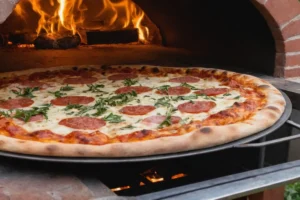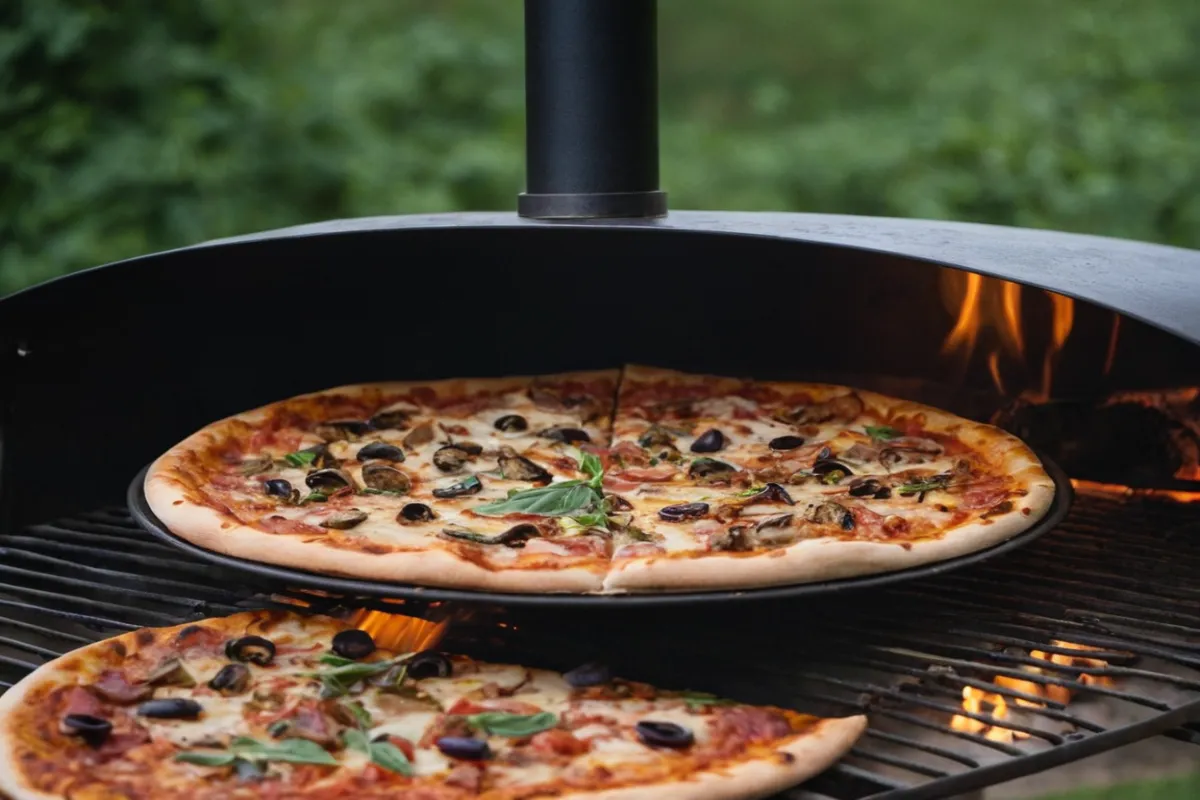The Ooni pizza oven is celebrated for its ability to reach incredibly high temperatures, creating pizzas that rival those from professional pizzerias. However, determining the optimal temperature for your Ooni pizza oven can be a bit of a science, one that involves understanding your specific needs, the type of pizza you’re making, and how to properly manage the oven’s heat.
Understanding the Basics of Ooni Pizza Ovens
What Makes Ooni Pizza Ovens Unique?
Ooni pizza ovens stand out for their ability to reach temperatures as high as 950°F (510°C) within just 15 minutes. This rapid heating is one of the reasons Ooni ovens are so popular among pizza enthusiasts. The high temperature allows you to cook a pizza in just 60-90 seconds, achieving the perfect balance of a crispy crust and gooey cheese.
The design of the Ooni oven is also unique. These ovens are typically compact, making them ideal for outdoor cooking. They come in various models, each designed to use different types of fuel, including wood, charcoal, and gas. The choice of fuel can also influence the temperature control and the flavor of your pizza, adding another layer of complexity to finding the ideal cooking temperature.
The Importance of Temperature in Pizza Making
Temperature is arguably the most critical factor in pizza making. The temperature of your oven affects everything from the texture of the crust to the meltiness of the cheese. In traditional wood-fired pizza ovens, temperatures can soar above 900°F, allowing pizzas to cook very quickly, which is key to achieving that perfect Neapolitan pizza—thin, crispy on the outside, and soft on the inside.
With an Ooni oven, you have the ability to replicate these conditions, but controlling the temperature can be more challenging than with a traditional oven. Unlike a conventional kitchen oven, where temperatures are controlled with the turn of a dial, managing an Ooni oven requires a bit more finesse, especially when using wood or charcoal as fuel.
Finding the Best Temperature for Your Ooni Pizza Oven
Optimal Temperature Range
For most Ooni pizza ovens, the optimal temperature for cooking a pizza is around 750°F to 900°F (400°C to 485°C). At this temperature range, you can achieve the best balance between cooking the crust quickly while ensuring the toppings are perfectly cooked.
Neapolitan Pizza: The Gold Standard
If you’re aiming to make a classic Neapolitan pizza, 850°F to 900°F (450°C to 485°C) is ideal. At these high temperatures, your pizza will cook in about 60-90 seconds. The intense heat ensures that the dough puffs up quickly, creating the characteristic airy, leopard-spotted crust that Neapolitan pizzas are known for.
New York-Style Pizza: A Slightly Cooler Approach
For a New York-style pizza, which typically has a thinner, crisper crust, a slightly lower temperature of around 700°F to 750°F (370°C to 400°C) is more appropriate. This temperature allows the crust to cook thoroughly without burning, while giving the cheese and toppings enough time to melt and cook through.
Adjusting for Other Styles
If you’re experimenting with other pizza styles, such as Chicago deep-dish or Sicilian, you might need to lower the temperature further, to around 600°F to 700°F (315°C to 370°C). These styles of pizza are thicker and require more time to cook all the way through, so a lower temperature helps prevent the crust from burning before the interior is cooked.
The Role of Dough Hydration
The hydration level of your dough—essentially how much water is in the dough—can also impact the ideal cooking temperature. A higher hydration dough (around 70-75% water) can withstand higher temperatures without burning, as the additional water content helps to regulate the cooking process. Conversely, a lower hydration dough (less than 65% water) might require a slightly lower temperature to prevent charring.
How to Measure and Control Temperature in an Ooni Oven
Using an Infrared Thermometer
One of the best tools for measuring the temperature of your Ooni pizza oven is an infrared thermometer. These devices allow you to quickly and accurately measure the temperature of the oven floor, which is crucial for ensuring that your pizza cooks evenly.
To use an infrared thermometer, simply point it at the center of the oven floor before placing your pizza inside. Ideally, you should take multiple readings from different spots to ensure that the heat is evenly distributed. This can help you identify any hot or cool spots that might affect how your pizza cooks.
Managing Heat with Different Fuels
The type of fuel you use in your Ooni oven can also affect how you manage temperature.
Wood and Charcoal
Wood and charcoal are popular fuel choices for Ooni ovens because they add a smoky flavor to the pizza. However, they can be a bit tricky to manage in terms of maintaining a consistent temperature.
When using wood or charcoal, it’s important to start with small, manageable pieces of fuel and add them gradually to avoid large temperature spikes. It’s also helpful to keep a close eye on the flames and adjust the fuel as needed to maintain the desired temperature.
Gas
Gas-powered Ooni ovens offer more straightforward temperature control, similar to what you would find in a conventional kitchen oven. With gas, you can easily adjust the flame using a control knob, making it easier to maintain a consistent temperature. Gas is also a cleaner fuel, reducing the amount of soot and ash that can accumulate inside the oven.
Common Challenges and How to Overcome Them
Overheating the Oven
One of the most common issues people face with Ooni ovens is overheating. It’s easy to get the oven too hot, especially when using wood or charcoal, leading to pizzas that burn on the outside before the inside is fully cooked.
Tips to Avoid Overheating
- Preheat with Caution: Start by preheating the oven gradually. Don’t overload it with fuel at the beginning; instead, build the heat slowly.
- Monitor Constantly: Use your infrared thermometer regularly to check the temperature. If you notice the oven getting too hot, give it a few minutes to cool down before adding your pizza.
- Use Less Fuel: When using wood or charcoal, try using smaller pieces of fuel and add them slowly to maintain a steady temperature rather than letting it spike too high.
Uneven Cooking
Another challenge is uneven cooking, where one side of the pizza cooks faster than the other. This can be due to hot spots within the oven or uneven dough thickness.
Solutions for Even Cooking
- Rotate Your Pizza: Rotate your pizza halfway through cooking to ensure that all sides cook evenly. This is especially important when dealing with very high temperatures, where even a few seconds can make a big difference.
- Check Dough Thickness: Make sure your dough is evenly stretched before placing it in the oven. Thicker areas will take longer to cook, leading to uneven results.
- Heat Distribution: If you consistently notice hot spots, try adjusting the placement of your fuel or use a pizza stone to help distribute heat more evenly.
Burning the Crust
Burning the crust is a common issue, especially for beginners who are not yet familiar with managing high temperatures.
Preventing Burnt Crusts
- Monitor Temperature: Always monitor the temperature of your oven floor before placing your pizza inside. If it’s too hot, wait a few minutes for it to cool down.
- Use High-Hydration Dough: A higher hydration dough can withstand higher temperatures, reducing the risk of burning.
- Quick Cooking Times: At high temperatures, pizzas cook in under two minutes. Be prepared to move quickly and remove the pizza as soon as it’s done to avoid burning.
Enhancing Your Ooni Pizza Oven Experience
Experiment with Different Recipes
Part of the fun of owning an Ooni pizza oven is experimenting with different recipes and styles of pizza. Whether you prefer a classic Margherita or a more adventurous topping combination, playing around with different dough recipes, toppings, and cooking techniques can help you find what works best with your oven.
Exploring International Pizza Styles
Consider expanding your pizza repertoire by exploring international styles. From the thin-crusted Roman pizza to the thick, hearty Detroit-style pizza, different styles require different techniques and temperatures. Experimenting with these can help you better understand your oven and refine your skills.
Roman Pizza
Roman pizza, known for its thin and crispy crust, typically requires a lower temperature than Neapolitan pizza. Aim for around 700°F (370°C) to achieve the right texture without burning the thin dough.
Detroit-Style Pizza

For Detroit-style pizza, which is known for its thick, airy crust and caramelized cheese edges, you’ll want to lower the temperature to around 600°F (315°C). This slower cooking method allows the dough to rise and cook evenly without burning the bottom.
Advanced Techniques for the Ooni Oven
Once you’ve mastered the basics, you can try more advanced techniques to get the most out of your Ooni pizza oven.
Par-Baking
Par-baking involves partially baking the pizza dough before adding toppings. This technique is particularly useful for thicker pizzas or when using heavier toppings that might otherwise prevent the dough from cooking evenly.
Double-Cooking
For pizzas with lots of toppings, you might consider double-cooking. Start by cooking the pizza at a lower temperature until the crust is partially done, then increase the heat to finish off the toppings. This method ensures that both the crust and the toppings are cooked perfectly.
Frequently Asked Questions (FAQs)
Can I Use My Ooni Pizza Oven for Other Foods?
Yes, the Ooni pizza oven is versatile and can be used for cooking a variety of other foods, such as bread, vegetables, and even meats. The high heat of the oven is ideal for searing steaks or roasting vegetables quickly, while the wood or charcoal fuel options can add a unique smoky flavor.
How Long Does It Take to Cook a Pizza in an Ooni Oven?
At the optimal temperature of 750°F to 900°F, a pizza will typically cook in about 60-90 seconds. The exact time can vary depending on the thickness of the crust and the number of toppings, but with practice, you’ll be able to gauge the perfect timing.
What If My Pizza Is Burning Before the Cheese Melts?
If you find that your pizza crust is burning before the cheese has melted, try lowering the oven temperature slightly or moving the pizza further away from the direct flame. You can also try using a pizza screen or par-baking the crust to ensure even cooking.
How Do I Clean My Ooni Pizza Oven?
To clean your Ooni pizza oven, allow it to cool completely before removing any ash or debris. Use a brush to clean the stone baking board and wipe down the interior with a damp cloth. For gas-powered models, make sure to check and clean the burner regularly to ensure it operates efficiently.
What Is the Best Dough Recipe for Ooni Pizza Ovens?
For Ooni pizza ovens, a dough with a higher hydration level (around 70-75%) is often recommended. This type of dough can handle the high heat without burning and produces a light, airy crust. Experimenting with different flour types, such as Caputo 00 flour, can also yield excellent results.
Conclusion: Mastering Your Ooni Pizza Oven
The Ooni pizza oven is a powerful tool that, with a little practice and experimentation, can produce restaurant-quality pizzas at home. Understanding the optimal temperature settings and how to manage them is key to making the most of your Ooni oven. Whether you’re aiming for the perfect Neapolitan pizza or experimenting with different styles, mastering temperature control will help you achieve the best results every time.
Remember, pizza making is as much an art as it is a science. Don’t be afraid to experiment with different doughs, toppings, and temperatures to find what works best for you. With time and practice, you’ll be able to create delicious pizzas that are sure to impress your friends and family.

